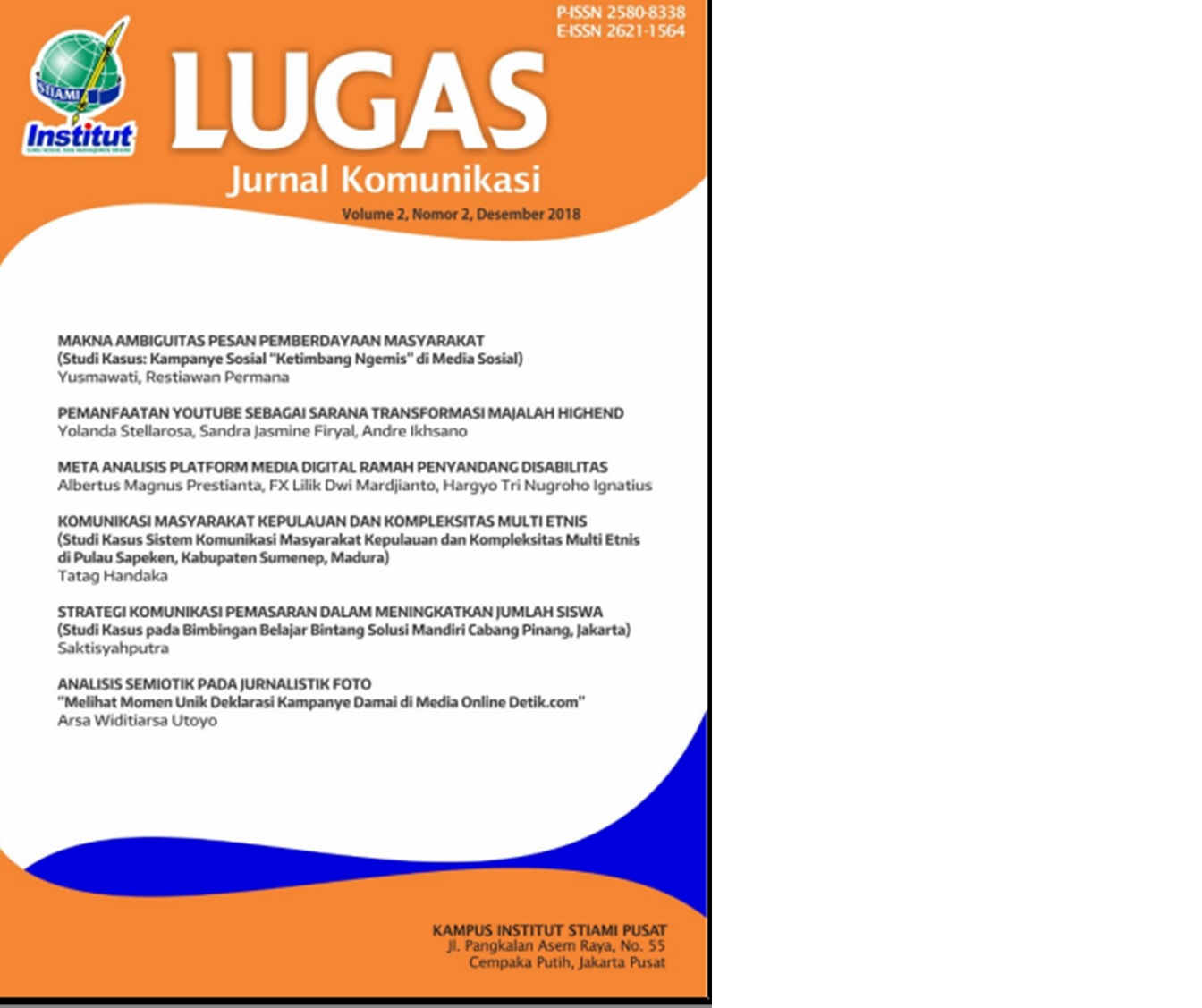Monetisasi dalam Strategi Komunikasi Lintas Budaya Bayu Skak Melalui Video Blog Youtube
DOI:
https://doi.org/10.31334/ljk.v3i1.415Keywords:
vlog, self-presentation, monetization, cross-cultural communication, co-cultural communication theoryAbstract
This study aims to understand the convergence of digital media into the reality of peak phenomenon of modern society needs in the present. The popular culture of exploiting new media as a means of monetization obscures the movitation and the purpose of new media itself is created.In the discussion, it will show how the owner of YouTube account Bayu Skak, doing self presentation as a representation of Java community in audio visual works, as well as how monetization runs on the video blogs he created in the media platform YouTube.The researchers concluded that the YouTube Media as one of the popular new media forms clearly offers space for modern society to make money and contribute to capitalism by providing an opportunity for account owners to present himself and work through audio-visual media.
References
Adler, R. B., & Rodman, G. 1991. Listening. In Understanding human communication. Fort Worth, Chicago: Holt, Rinehart and Winston, Inc.
Burgess, Jean & Joshua Green. YouTube. 2009. Online Video and Participatory Culture. UK: Politiy Press.
Hofstede, Geert. Gert Jan Hofstede, Michael Minkov. 2010. Cultures and Organizations: Software of the Mind. New York: McGraw Hill.
Hardiman, Francisco Budi. 1993. Kritik Ideologi, Pertauatan Pengetahuan dan Kepentingan. Yogyakarta: Kanisius.
Kuntowijoyo. 2001. Pengantar Ilmu Sejarah. Yogyakarta: Bentang Budaya, 2001.
Littlejohn, Stephen W., Karen A. Foss. 2012. Teori Komunikasi. Jakarta: Salemba Humanika
Martin, Judith dan Thomas K. Nakayama. 2007. Intercultural Communication in Contexts. New York: Mc Graw Hill International.
Mulyana, Deddy. 2007. Pengantar Ilmu Komunikasi. Bandung: PT. Remaja Rosdakarya.
Purba. Amir, dkk. 2006. Pengantar Ilmu Komunikasi. Medan: Pustaka Bangsa Press.
Strinati, Dominic. 2007. Populer Cutlure. Bandung: Penerbit Jejak.
Referensi Jurnal
Biel, Joan-Isaac da Oya Aran dan Daniel Gatica-Perez. 2011. You Are Known by How You Vlog: Personality Impression and Nonverbal Behavior in YouTube. Association for the Advancement of Artificial Intelligence.
Chand, Daniel. 2014. Mark Orbe’s cocultural theory. Journal of Communication. Illinois State University Vol 37: 372
Fadhal, Soraya dan Lestari Nurhajati. 2012. Identifikasi Identitas Kaum Muda di Tengah Media Digital, Studi Aktivitas Kaum Muda Indonesia di Youtube. Jakarta: Universitas Al-Azhar Indonesia.
Griffith, Maggie & Zizi Papacharissi. (2011). Looking for You: An Analysis of Video Blogs. First Monday, Volume 15, Number 1-4, January, 2010.
Misoch, S. 2014. Card Stories on YouTube: A New Frame for Online Self-Disclosure. Media and Communication, 2(1), 2-12.
Murdianto. 2018. Stereotipe, Prasangka dan Resistensinya (Studi Kasus pada Etnis Madura dan Tionghoa di Indonesia). Qalamuna, Vol. 10, No. 2, Juli - Desember 2018
Raun, Tobias. 2012. Out Online: Trans Self-representation and Community Building on YouTube. Roskilde University: Routledge
Simonsen, T. Mosebo. 2014. Examining Paratextual Theory and its Application in Digital Culture: The Functionality of Paratext on YouTube. Pennsylvania: IGI Global
Smith, Daniel R.. 2017. The Tragedy of Self in Digitised Popular Culture: The Existensial Consequences of Digital Fame on YouTube. Qualitative Research 1-16. DOI: 10.1177/1468794117700709
Suharyo. 2018. Nasib Bahasa Jawa & Bahasa Indonesia dalam Pandangan dan Sikap Bahasa Generasi Muda. NUSA, Vol. 13 No. 2 Mei 2018. DOI: 10.14710/nusa.13.2.244-255
Zalwia, Sulsalman Moita, dan Ambo Upe. 2018. Modernisasi dan Diskontinuitas Bahasa Daerah (Studi Kasus Penggunaan Bahasa Daerah Gu di Kelurahan Lakudo Kecamatan Lakudo Kabupaten Buton Tengah. Neo Societal, Vol. 3, No. 2, 2018.
Referensi Situs
http://tekno.liputan6.com/read/3019129/10-vlogger-indonesia-paling-populer#
Downloads
Published
Issue
Section
License

This work is licensed under a Creative Commons Attribution-NonCommercial-ShareAlike 4.0 International License.
Copyright Notice
Please find the rights and licenses in LUGAS Jurnal Komunikasi, spirit is to disseminate articles published are as free as possible. Under the Creative Commons license, LUGAS Jurnal Komunikasi permits users to copy, distribute, display, and perform the work for non-commercial purposes only. Users will also need to attribute authors and LUGAS Jurnal Komunikasion distributing works in the journal and other media of publications.
4.Co-Authorship
If the article was jointly prepared by more than one author, any authors submitting the manuscript warrants that he/she has been authorized by all co-authors to be agreed on this copyright and license notice (agreement) on their behalf, and agrees to inform his/her co-authors of the terms of this policy. LUGAS Jurnal Komunikasi will not be held liable for anything that may arise due to the author(s) internal dispute. LUGAS Jurnal Komunikasi will only communicate with the corresponding author.
5.Miscellaneous
LUGAS Jurnal Komunikasi will publish the article (or have it published) in the journal if the article’s editorial process is successfully completed. LUGAS Jurnal Komunikasi editors may modify the article to a style of punctuation, spelling, capitalization, referencing and usage that deems appropriate. The author acknowledges that the article may be published so that it will be publicly accessible and such access will be free of charge for the readers as mentioned in point 3.
Every accepted manuscript should be accompanied by "Copyright Transfer Agreement" prior to the article publication.





.png)

